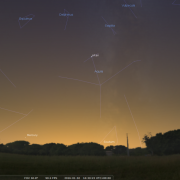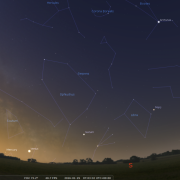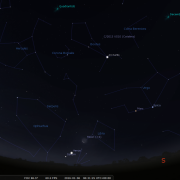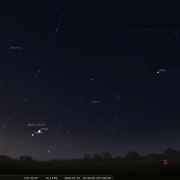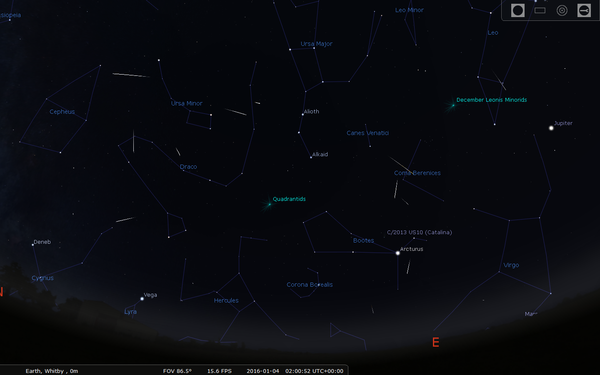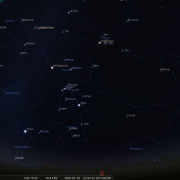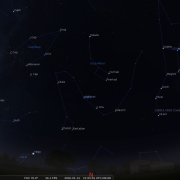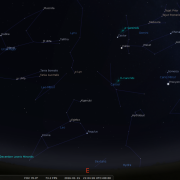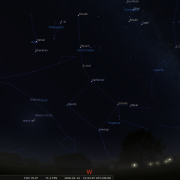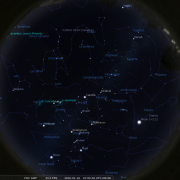In this month's Sky Notes:
Planetary Skylights

 Elusive Mercury may be glimpsed during the first and last week of January. Look for it as the New Year begins low above the South-West horizon from 16:15 to 16:40h. It will then drop from view only to reappear as a morning object just above the South-East horizon to the lower left of Venus around 07:00h during the last few days of January and into February. You will require a clear unobstructed horizon in order to locate it, look for fairly bright star in the twilight a binocular field above the horizon.
Elusive Mercury may be glimpsed during the first and last week of January. Look for it as the New Year begins low above the South-West horizon from 16:15 to 16:40h. It will then drop from view only to reappear as a morning object just above the South-East horizon to the lower left of Venus around 07:00h during the last few days of January and into February. You will require a clear unobstructed horizon in order to locate it, look for fairly bright star in the twilight a binocular field above the horizon.

 Conspicuous Jupiter is rising before midnight at the start of January before coming to dominate the late evening sky over in the east by the end of the month. However it should still primarily be considered an early morning object, and a fine one at that! Viewed through a telescope, look for the banding across the disk and the Galilean moons, visible as specks of light nearby. The Moon lies nearby on the 27th.
Conspicuous Jupiter is rising before midnight at the start of January before coming to dominate the late evening sky over in the east by the end of the month. However it should still primarily be considered an early morning object, and a fine one at that! Viewed through a telescope, look for the banding across the disk and the Galilean moons, visible as specks of light nearby. The Moon lies nearby on the 27th.

 As the New Year commences Mars, Venus and Saturn all reside in the dawn sky – lower left of Jupiter. The orange hue of Mars lies to the left of white Spica (chief star in Virgo). Brilliant Venus resides lower left of Mars, not that far above the South-East horizon.
As the New Year commences Mars, Venus and Saturn all reside in the dawn sky – lower left of Jupiter. The orange hue of Mars lies to the left of white Spica (chief star in Virgo). Brilliant Venus resides lower left of Mars, not that far above the South-East horizon.
The highlight of the month is an extremely close conjunction of Venus and Saturn on the 9th View around 07:00h, when to the naked eye they will appear exceptionally close. Even through a scope at low power they may both appear in the same field of view. Venus will exhibit a waning crescent phase. Saturn will be a glorious spectacle with the ring system wide open, with Titan nearby. As the month progresses Venus drops out of view
The Moon passes through the dawn sky close to the morning planets from the 3rd to the 7th.
Watch, as the moon occults several members of The Hyades star cluster (including Aldebaran, the ‘fiery eye’ of Taurus-the Bull) over the night of the 19/20th The Hyades is the ‘V’ shaped cluster in Taurus.
 Earth reaches perihelion (closest to the Sun) on January 2nd at 23:00h UT some 147 million km (91.73 million miles) from our nearest star.
Earth reaches perihelion (closest to the Sun) on January 2nd at 23:00h UT some 147 million km (91.73 million miles) from our nearest star.
New Year Meteors

The year starts with one of the more prolific meteor showers, the Quadrantids, active between Jan 1- 6th The short lived shower peak normally falls in the early hours of the 4th, around 02:00-04:00h, one reason it is often missed by observers.
Peak zenith hourly rates may exceed 80 per hour, but observers usually see 25-40 per hour. Quadrantids appear to radiate from the now defunct constellation of Quadrans Muralis, which was removed from sky charts in 1922, but used to lie at the junction between Hercules, Bootes and Ursa Major. This position in the sky is located low to the North at the time of the peak, so view in any direction this one.
January 2016 Sky Charts
Click each image to see a full-size Sky Chart:
|
Looking South
Mid January - 21:00h |
Looking North |
|
Looking East
Mid January - 21:00h |
Looking West
Mid January - 21:00h |
|
|
|
|
Overview
Mid January - 21:00h |
|
Additional Image Credits:
- Planets and Comets where not otherwise mentioned: NASA
- Sky Charts: Stellarium Software
- Log in to post comments

